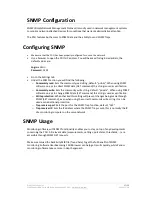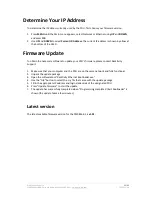
© 2011 Racktivity Inc.
17/25
2100 Seaport Blvd., Suite 400, Redwood City 94063, USA – www.racktivity.com
v 2013.11.18
SNMP Configuration
SNMP (Simple Network Management Protocol) is mostly used in network management systems
to monitor network-attached devices for conditions that warrant administrative attention.
The PDU features both access to SNMP data and the ability to send SNMP Traps.
Configuring SNMP
•
Make sure that the PDU has been properly configured for use on the network.
•
Use a browser to open the PDU's IP address. You will be asked for login credentials, the
default values are:
Login
: admin
Password
: 1234
•
Go to the Settings tab
•
Under the SNMP section you will find the following:
o
Community
read
: Sets the community read string, default: "public". When using SNMP
software on a pc to collect SNMP data (GET command) this string is used as verification
o
Community
write
: Sets the community write string, default: "private". When using SNMP
software on a pc to change SNMP data (SET command) this string is used as verification
o
Write
protection
: When checked this setting will prevent changes being made through
SNMP (SET command), even when using the correct Community write string. It can be
used as an additional protection
o
Trap
receiver
port
: Sets the port for the SNMP Trap function, default: "162"
o
Trap
receiver
IP
: Sets the IP address where the SNMP Trap is sent, this is normally the IP
of a monitoring computer on the same network
SNMP Usage
Monitoring software with SNMP functionality enables you to stay on top of any developments
concerning the PDU. All relevant data (measurements, settings, port states, thresholds,...) are
accessible through SNMP GET requests.
Make sure to load the Racktivity MIB file (found here) to get the full benefits of SNMP
monitoring. Software like iReasoning's MIB Browser can help get results quickly, while Zenoss
monitoring software takes a more in depth approach.
Summary of Contents for PM0816-01
Page 1: ...User manual PM0816 01 ...























